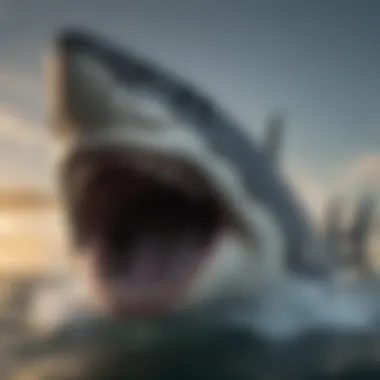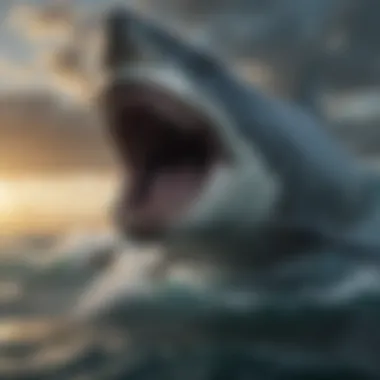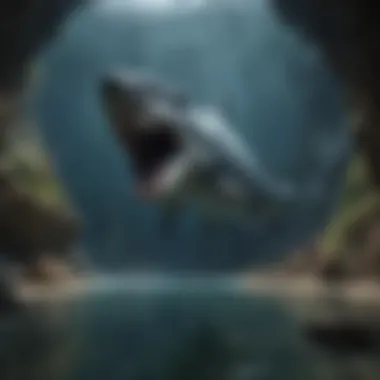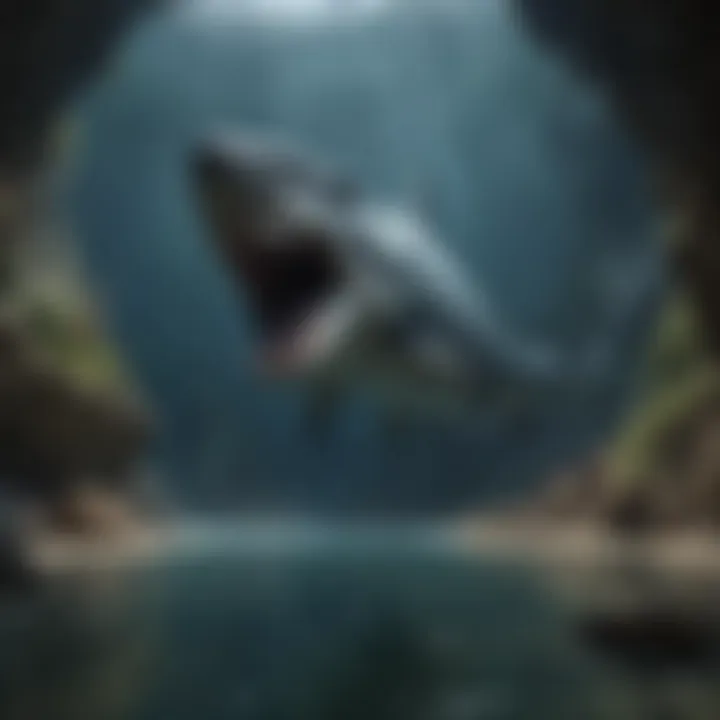Exploring the Megalodon: The Giant Shark of Ancient Oceans


Intro
The megalodon, a name that invokes wonder and imagination, stands as a titan of the prehistoric seas. This colossal shark isn't just a figure of legend; it was a reality that existed millions of years ago. Imagine a predator so vast that it dwarfed even the largest contemporary whales. For enthusiasts of paleontology, marine biology, and natural history alike, the megalodon offers a unique glimpse into a time when Earth’s oceans were ruled by breathtaking giants.
Perusing through fossils, one gains insight into the immense size and biologically advanced structures of this creature. Beyond its physical attributes, the megalodon's role in the marine ecosystem sparks discussions around predation, extinction, and evolutionary adaptations. Furthermore, the cultural significance it holds today only deepens the intrigue surrounding this giant shark.
As we unfold the layers of history and significance behind the megalodon, we will explore its origins, methods of identification, and its hold on human fascination. Join us as we plunge into the depths of understanding regarding one of the ocean's most formidable predators.
History and Origins
The megalodon, scientifically recognized as Otodus megalodon, thrived during the Cenozoic era, approximately 23 to 3.6 million years ago. This time period witnessed significant geological and climatic changes, setting the stage for the rise and fall of various marine organisms.
Overview of Collectibles, Rocks, and Fossils
Collecting megalodon fossils has become a rewarding endeavor for many. Fossilized teeth, often measuring over seven inches, are the most frequently found remnants and serve as prized collectibles for both enthusiasts and scientists. Hunters comb beaches and submerged land formations, eager to uncover these ancient treasures hidden within layers of sediment.
The formation of megalodon teeth began with the sharp, serrated edges vital for hunting. These teeth are often found in locations that were once shallow marine environments, sea floors rich in nutrients supporting diverse ecosystems. Notably, places such as the Atlantic Coast of the United States and areas around South Carolina are famous for megalodon tooth finds.
- Key collectible items related to the megalodon include:
- Fossilized teeth
- Jaw fragments
- Vertebrae
- Coprolites (fossilized feces, providing insights into the diet and habits)
It’s fascinating how the megalodon, once a dominant force in the oceans, now graces display cases in homes, museums, and educational institutions around the globe.
Historical Significance and Cultural Impact
Throughout history, the legend of the megalodon has captured human imagination. Ancient mariners may have spun tales of giant sea monsters based on remnants like those teeth we find today. In modern times, the megalodon has become a cultural icon, dominating documentaries, novels, and even blockbuster films. From films like "The Meg" to thrillers that play on the fear of deep-sea monsters, the megalodon's legacy continues to influence contemporary culture.
Its extinction, dating back approximately 3.6 million years, raises questions not only about the species itself but also about our oceans' ecosystems during that time. The lost presence of such a predator signifies substantial shifts in marine biodiversity, altering food webs and the survival of other species. This connects to a broader narrative concerning climate change, ecological balance, and our present-day oceanic environment.
As we delve into the megalodon's identification and classification, let us uncover the scientific façades that give this creature its unique identity.
Identification and Classification
Recognizing megalodon remains requires a keen eye and some foundational knowledge in paleontological principles. Distinguishing these ancient artifacts, especially the teeth, from other marine fossils enriches the digging experience for collectors.
Guide to Identifying Rocks and Fossils
Megalodon teeth can be identified by several distinct characteristics:
- Size: As mentioned earlier, these can reach massive sizes."
- Shape: The teeth are triangular and generally have a robust, serrated edge, suitable for gripping and tearing through flesh.
- Coloration: Typically, the coloration can range from black to shades of brown or green, depending on the minerals present in their environment during fossilization.
- Root shape: The root often resembles a distinctive, rounded triangular form which is a hallmark of megalodon teeth.
Collectors often examine these traits closely, using guides or resources, including links to Wikipedia and Britannica for more in-depth information.
Common Types and Variations
While the megalodon is primarily known for its size and hunting prowess, several variations of its teeth exist:
- Standard teeth: The typical large specimens found in many locations.
- Fossilized fragments: Pieces that provide clues about the age and environmental conditions of the time.
- Rare abnormal teeth: Instances of anomalies in shape or size, which are often sought after by collectors for their uniqueness.
The tapestry of megalodon fossils paints a vivid picture of its past, inviting exploration into not just the creature itself but the environmental backdrop of prehistoric epochs.
As we approach the discussion of the megalodon’s eventual extinction, it will open the door to much broader ecological discussions, raising questions about the balance of life in our oceans through time.
Foreword to Megalodon
Understanding the megalodon is crucial for appreciating not just the wonders of marine life but also the intricacies of our planet's evolutionary history. This prehistoric giant wasn't just any shark; it represented a pinnacle in marine adaptation and predation. The mere mention of its name conjures images of vast ocean depths, where it ruled as one of the apex predators of its time. In this section, we will unravel the sheer magnitude of its existence while pondering over its ecological impact and the lessons we drawn from its extinction.
Overview of the Megalodon
The megalodon, scientifically called Carcharocles megalodon, was a colossal shark that lived approximately 23 to 3.6 million years ago during the Cenozoic Era. Size estimates suggest it could reach lengths of up to 60 feet or more, dwarfing today's largest sharks. Its massive jaws were lined with serrated teeth that measured several inches in length. These teeth, fossilized and robust, reveal a glimpse into its predatory nature, suggesting it was equipped to tackle large marine mammals, including whales.
The megalodon inhabited a range of marine environments, from coastal shallows to the open ocean, showcasing flexibility in its habitat. Fossil remains have been discovered on various continents, indicating its broad geographic range. This adaptability provided it with diverse prey options.
Significance in Marine History
The megalodon’s role in marine history is not just about its size; it’s about the narrative of survival and evolution in changing ecosystems. As a top predator, it played an integral part in maintaining the health of marine populations and the overall balance of ocean ecosystems. Its hunting strategies likely involved both speed and stealth, ensuring that it had a competitive edge over its prey.
When we contemplate the extinction of such a formidable creature, we find ourselves at the crossroads of climate evolution and ecological shifts. The megalodon’s decline, likely due to fluctuating ocean temperatures and changes in prey availability, serves as a crucial case study. It highlights how species adapt or face extinction in response to environmental changes.


“The history of the megalodon is a powerful reminder: adapt or perish.”
Moreover, the legacy of the megalodon transcends pure biology; it echoes through time in the form of cultural references. From folklore to films, its monstrous image captivates our imagination, highlighting humanity's enduring fascination with these ancient leviathans. In the following sections, we will delve deeper into the life and times of the megalodon, comparing it to its modern relatives, exploring its habitat, and examining the theories surrounding its extinction.
Size Comparison: Megalodon versus Modern Sharks
Understanding the size comparison between the megalodon and today’s shark species isn’t just about numbers but also reveals insights into the evolutionary paths and ecological roles that these magnificent creatures played in their respective eras. The sheer scale of the megalodon, alongside its predatory prowess, sets it apart from modern sharks, providing a stark illustration of how marine environments have changed over millions of years.
Dimensions of Megalodon
The megalodon is believed to have reached astounding lengths—estimates range from 40 to even 60 feet, with some overenthusiastic speculations suggesting lengths of up to 82 feet. In comparison, today's largest sharks—like the whale shark—top out around 40 feet. The size of megalodon is not merely a number; it signifies dominance. It was equipped with a massive jaw that could exert unprecedented pressure, allowing it to take down prey larger than itself with ease.
One might liken the size of the megalodon to comparing a school bus to a sedan. The sheer bulk of this ancient predator made it a leviathan of the seas, capable of instilling fear into nearly every marine creature of its time.
Contrasting Features with Great White Sharks
When one examines the megalodon alongside the great white shark, prominent differences emerge. The megalodon’s teeth, which could reach over 7 inches in length, were not just larger but also different in design compared to the serrated teeth of the great white. While both sharks share some similarities as apex predators, the megalodon had a more robust body and thicker vertebrae, designed to support its massive weight and enable swift movement through the waters, overcoming its direct descendants in explosive power.
Great whites, on the other hand, are sleek. Their agility in the water belies their size, as they rely on their speed and stealth, a tactic that differs fundamentally from the brute force showcased by the megalodon. The contrast reveals much about their hunting strategies and ecological niches.
Largest Extant Sharks
In discussing the largest extant sharks today, three species stand out for comparison:
Whale Shark
The whale shark is the largest living fish, commonly found in warm waters. It reaches lengths of up to 40 feet while feeding primarily on plankton—there’s a significant contrast here. Unlike the predatory behavior of megalodon, the whale shark’s feeding method is passive. This emphasizes a major evolutionary shift; while megalodon was a fearsome predator, the whale shark thrives in calm, nutrient-rich waters as a filter feeder. The unique feature of its large gills allows it to filter vast amounts of water, showcasing the diversity in adaptations among marine creatures.
Basking Shark
Basking sharks, another filter feeder, are the second-largest fish species, trailing behind the whale shark. They can grow up to 30 feet long. Drawing a line back to the megalodon, the basking shark’s thriving strategy shows how varying feeding habits help them occupy different ecological niches today. Despite their size, basking sharks are known for their docile temperament, relying on open water and their massive gill rakers to catch food. This showcases the evolutionary shift where sheer size is less important than adaptability in feeding strategies.
Tiger Shark
Tiger sharks are renowned for their voracious appetite and are often considered the garbage cans of the sea, consuming a diverse range of prey. They grow to an impressive 16 feet and are more aggressive than their passively feeding cousins. The tiger shark’s hunting prowess isn't comparable to the megalodon's brute strength, but it highlights a different niche altogether—one where adaptability and opportunistic feeding define survival. This adaptation helps connect their lineage back to the predatory traits of the mighty megalodon.
While the size and features of sharks have adapted over time, the legacy of the megalodon still haunts the depths of our understanding of marine evolution.
The Physiology of Megalodon
The physiology of the megalodon is not just a topic of interest; it's a window into understanding how this colossal creature thrived in the vast prehistoric oceans. Examining its anatomical features provides insights into its predatory capabilities, its role within the marine ecosystem, and the sheer scale of its existence. The megalodon's design and structure informed its hunting strategies and environmental adaptations, making it a fascinating subject for paleontologists and enthusiasts alike.
Jaw Structure and Teeth
One of the most striking features of the megalodon is its jaw. The structure is a beautifully crafted machinery of nature, exquisitely adapted to its role as an apex predator. With jaws that could open wider than a car, the megalodon's bite was a force to reckon with.
Its teeth were not just tools for eating; they were weapons. Imagine teeth that could grow up to seven inches long, serrated and robust, capable of slicing through the flesh of whales with ease. Each tooth was a testament to the evolution of predation. Fossil evidence shows that megalodon teeth are among the most common shark fossils found today, providing crucial data on size and feeding habits.
- Key Points of Jaw Structure:
- Size: Capable of opening up to 150 degrees, larger than contemporary sharks.
- Shape: Triangular and serrated, designed for gripping and tearing flesh.
- Placement: A unique arrangement allowed for greater force during biting.
"The megalodon's jaw is not just a feature but a statement of its dominance in the food chain."
Anatomical Features Supporting Size
The megalodon's sheer size necessitated unique anatomical adaptations to support its gigantic frame. One cannot simply chalk it up to genetics; various structural elements collaborated to sustain its life in the deep, often hostile environments of prehistoric oceans.
- Body Shape: The megalodon had a streamlined body, which reduced drag, allowing it to swim efficiently in search of prey. The robust build also played a role in its ability to withstand high-pressure environments and perform rapid movements.
- Muscle and Strength: Powerful musculature, especially around the jaw and snout, aided in swift attacks on large prey. This muscular system was likely bespoke for powerful thrusts, balancing speed and stamina.
- Skull Structure: A lightweight, cartilaginous skull structure reduced overall body weight but did not compromise strength. This anatomical choice allowed for a larger head without the accompanying weight of bone, contributing to both hunting efficacy and buoyancy.
When synthesizing these aspects of megalodon's physiology, it becomes clear that every feature was not just happenstance, but an evolutionary marvel designed for survival and dominance. This unique combination of anatomy put the megalodon at the top of the food chain, showcasing how powerful evolutionary forces can shape life in the oceans.
Habitat of Megalodon
Understanding the habitat of Megalodon is essential in piecing together its life story. These colossal sharks thrived in ancient seas, which provided the right conditions for growth and predation. By analyzing their habitat, we can better appreciate their role in prehistoric marine ecosystems and the dynamics that contributed to their existence.
Geological Timeline and Distribution
Megalodon roamed the Earth from the late Oligocene to the early Pleistocene, a time frame stretching from around 23 million to 2.6 million years ago. During this geological timeline, their presence has been noted across a wide range of marine environments.
- Fossil evidence indicates that Megalodon inhabited oceans worldwide, including:


- The Atlantic
- The Pacific
- The Indian Oceans
Its remains have been discovered on every continent except Antarctica, suggesting adaptability to various marine conditions.
The occurrences of Megalodon fossils in different sediment layers reveal insights about their distribution. The vast range indicates these sharks were not picky eaters and were likely opportunistic predators that thrived in productive waters. They preferred warmer waters, which likely influenced their distribution patterns as their habitat changed with the Earth’s climate over millions of years.
Environmental Conditions of the Era
The environmental conditions during Megalodon's reign played a pivotal role in defining their habitat. Approximately 15 million years ago, the Earth experienced a warmer climate, which created lush marine ecosystems. This facilitated the abundance of prey species, crucial for a top predator like Megalodon.
Some key conditions that characterized their environment include:
- Temperature: Warm waters would have fostered the development of thriving ecosystems, rich in nutrients and prey species.
- Oxygen Levels: High oxygen levels in the ocean encouraged diverse marine life, supporting larger species along the food chain.
- Geographical Features: The expansive continental shelves provided ample hunting grounds, where Megalodon could easily ambush whales and other large prey.
Extinction: Causes and Theories
Exploring the extinction of the megalodon is crucial for understanding both its role in prehistoric marine ecosystems and the broader implications this has for contemporary marine biodiversity. The mighty megalodon was not just a predator; it shaped the oceanic environment of its time. The causes of its extinction are a tapestry woven from various threads—climate change, competition with other species, and even myths surrounding the creature itself. Each theory sheds light on how environmental factors and species interactions can dramatically alter the fate of even the most formidable creatures.
Climate Change and Ecosystem Dynamics
Climate change is often viewed as a modern concern, but it has played a substantial role in past extinctions too. During the late Miocene to the Pliocene epochs, significant shifts in global temperatures and ocean currents occurred. These changes would have affected the distribution and availability of key prey species for the megalodon, such as whales and large fish.
- As temperatures rose, sea levels fluctuated, altering coastal habitats and potentially disrupting breeding grounds essential for various marine organisms.
- Warmer waters might have promoted the bloom of algae, causing shifts in oxygen levels and the overall health of marine ecosystems.
- The alteration in prey dynamics could have heavily impacted the predator-prey relationship. If megalodon's preferred meals became scarce, survival would be an uphill battle.
"Climate change didn’t simply rearrange the furniture—it took the whole house down for the megoladon."
Competition with Other Species
When discussing the fall of the megalodon, one must also consider the emergence of other large predators around the same time, particularly the great white shark. This competition could have been a double-edged sword for the megalodon.
- Newer species adapted more swiftly to changing environments, perhaps evolving better hunting strategies or different dietary preferences that allowed them to thrive despite ecological changes.
- Increased competition would have strained resources, forcing megalodons to hunt in less favorable conditions or areas already dominated by other species.
- A notable theory posits that as competition heated up, the megalodon's size—a factor that had once ensured dominance—could have become a liability in increasingly tumultuous waters where agility counted over sheer size.
Human Influence and Myths
Although humans did not play a direct role in the extinction of megalodon—after all, these giant sharks vanished long before our time—their cultural representations and the fascination surrounding such creatures do impact how we perceive marine life today. Myths and stories evolved, often painting megalodon as a monstrous, unkillable predator, which further fueled its legend.
- This cultural allure may inspire conservation efforts or create unrealistic fears that affect the way we manage modern shark populations. Understanding this relationship is key for rock and fossil collectors, who often seek out remnants tying past creatures to present narratives.
- Popular media also shapes perceptions; when we glorify or vilify fictional representations of megalodon, it can influence real-life marine policies, conservation priorities, and funding for research efforts that could prevent current apex predators from facing a similar demise.
Examining these causes offers a multifaceted understanding of not only the megalodon's extinction but serves as a cautionary tale about extinction dynamics in our current marine ecosystems.
Fossil Evidence and Discoveries
Fossil evidence plays a crucial role in understanding the megalodon, offering insights about its characteristics, behaviors, and even its environment. Through the lens of paleontology, these remnants grant us the ability to piece together a living portrait of a creature that swam the oceans millions of years ago. The way megalodon fossils are studied can yield information about its biology and interactions with other marine species, making this field of research invaluable for grasping the broader narrative of marine evolutionary history.
Key Paleontological Findings
The findings associated with megalodon fossils are diverse and varied. A particularly noteworthy discovery is that of massive teeth. The teeth of the megalodon are quite striking, measuring over 7 inches in length. These artifacts have been uncovered in various locations, indicating a widespread distribution of this predator across ancient oceans. These fossilized remains are not mere remnants; they are clues to understanding the dietary habits of the megalodon.
Researchers have discovered that the megalodon primarily preyed on large marine animals, including whales. Fossilized bite marks found on whale bones add weight to the thesis that this shark was a top predator. The interaction between megalodon and other species became a key part of its ecological narrative. An analysis of these bite marks can also tell us about the force of their jaws and the adaptive strategies used to capture prey.
"Fossils tell stories that often go unmatched in modern observation; they bridge millions of years and offer glimpses into a world long gone."
Methods in Fossil Reconstruction
Reconstructing the megalodon from fossil evidence is no small feat; it requires a harmonious blend of scientific rigor and imagination. Paleontologists combine multiple approaches to piece together what megalodon would have looked like and how it fed, moved, and survived in its milieu.
One common method is comparative anatomy, wherein researchers study the skeletons of modern sharks. By understanding the relationships between megalodon fossils and those of its contemporary relatives, scientists can infer how it might have functioned as an apex predator. Additionally, techniques such as CT scanning allow for internal examination of fossils without damaging them, thus revealing details about its growth patterns and potential pathology.
Another innovative approach used in fossil reconstruction is computer modeling. Using digital software, scientists can simulate the biomechanics of the megalodon, testing hypotheses about swimming capabilities and feeding strategies. This synthesis of data from different scientific fields opens up new possibilities for understanding not just megalodon but other prehistoric marine life as well.
In summary, fossil evidence and discoveries are foundational to any discussion about the megalodon. They guide our understanding of its ecology, behavior, and the environment it inhabited. The innovations in fossil reconstruction further enrich this dialogue, marrying artistic interpretation with scientific analysis, ultimately deepening our appreciation for this magnificent prehistoric shark.
Megalodon in Popular Culture
The megalodon has carved a unique niche in popular culture, fascinating audiences across different media. From blockbuster movies to gripping novels, its fearsome reputation as a colossal predator commands attention. This cultural significance is not merely entertainment; it offers a lens through which we can examine human fascination with the ancient world and our relationship with the ocean.
Exploring the megalodon in popular culture illuminates various themes such as fear, survival, and the mysteries of prehistoric life. It acts as a bridge, connecting the scientific community with the general public. When individuals engage with megalodon stories, whether fictional or based on facts, they are, in essence, participating in a broader discourse about marine biology and extinction. This fusion of education and entertainment deepens our understanding and appreciation of life on Earth, past and present.
Film and Literature Representations


Megalodon is frequently portrayed in films as a monstrous force, often depicted in exaggerated and sensationalized scenarios. An example is the movie "The Meg," where a megalodon is unleashed from the depths of the Mariana Trench, creating chaos in its wake. Such portrayals feed into our primal fears of the ocean, tapping into archetypal fears of the unknown.
On the literary side, novels like "Megalodon: The Elemental" weave intricate narratives around these giant sharks. These narratives often explore themes of adventure, danger, and the unpredictability of nature. They provide both thrill and suspense, thus enthralling readers with the vivid representation of what life might have been like alongside such an apex predator.
Notably, not all representations are purely fictional. Documentaries and educational films aim to inform audiences regarding the scientific aspects of megalodon biology and behavior. This dual approach helps cultivate a balanced perspective, sparking curiosity and genuine interest in paleontology.
Science versus Fiction
The distinction between science and fiction when it comes to megalodon can be quite blurred in popular culture. Often, films and books take liberties with the scientific facts, leading to a cocktail of truth and imagination. For instance, while the idea of the megalodon existing in modern times might thrill audiences, paleontological evidence firmly places its extinction millions of years ago. Understanding this boundary is crucial to appreciate the storytelling behind megalodon myths.
Indeed, many films exaggerate the size or behavior of megalodon, presenting it as a relentless, stealthy killer, rather than a creature that thrived in its time based on specific environmental conditions. This selective interpretation can lead to misconceptions about marine predators and their ecological role.
"Megalodon's story is as much about our collective imagination as it is about the fossil records that define its existence."
In essence, while pop culture dramatizes the megalodon, the underlying scientific study provides grounding. This blend of myth and reality culminates in an engaging narrative that both informs and entertains. It prompts audiences to dive deeper, fostering an ongoing dialogue about the nature of extinction, evolution, and marine ecosystems.
Contemporary Research on Megalodon
Research on the megalodon has taken strides in recent years, shedding light on the life and times of this marine giant. Currently, scientists are using advanced methodologies and technologies to glean deeper insights into its biology, behaviors, and ecological role in prehistoric oceans. Unlike other extinct species, the megalodon captures both the scientific community's mind and the public's imagination, thus driving funding and curiosity.
New approaches to this topic not only enhance our understanding of the megalodon but also spotlight its relevance in today’s marine conservation efforts. Lessons drawn from its extinction can inform strategies aimed at safeguarding today’s ocean dwellers.
Current Scientific Studies
Scientific investigations into megalodon have branched out into diverse areas, including:
- Paleobiology: This branch focuses on understanding megalodon’s life cycle, growth patterns, and prey preferences. Studies analyzing tooth morphology can indicate age and dietary habits, providing a clearer picture of how this predator functioned within its ecosystem.
- Genetics: Genetic analysis of fossils, although limited, offers hints about the evolutionary relationships between megalodon and its modern relatives. Newer techniques like ancient DNA analysis are becoming legitimate methods for diving deeper into its lineage.
- Ecological Impact: Investigations often emphasize the megalodon's role in shaping marine ecosystems. Studies aim to uncover its interactions with other marine species and how those relationships contributed to the balance of the ancient oceans.
Research efforts are often published in prominent scientific journals, and findings frequently stir discussions among marine biologists. Indeed, the quest to understand megalodon brings scientists ever closer to the intricacies of ancient marine life.
Technological Advances in Paleontology
The field of paleontology has seen remarkable technological advances that have significantly improved research capabilities concerning megalodon. Key innovations include:
- CT Scanning: This technology allows researchers to look into fossilized remains without damaging them. By revealing internal structures, scientists can ascertain anatomical features that were previously unseen, providing a more comprehensive understanding of the megalodon's biology.
- 3D Modeling: With the help of digital modeling software, paleontologists can create accurate reconstructions of megalodon skeletons and teeth. This technique helps study its size, movement, and feeding methods in a more visual and engaging manner.
- Isotope Analysis: By examining isotopic signatures within megalodon teeth, researchers can deduce information about its migration patterns and feeding habits. This technique plays a crucial role in establishing the megalodon's ecological preferences in relation to its environment.
"The past is but a prologue, and every new study on megalodon reveals a page that enriches our understanding of marine history."
The fusion of these advanced technologies has opened new avenues of research and inquiry. It not only enhances what we know about this giant shark but also underscores the importance of interdisciplinary collaboration in unearthing the secrets of the prehistoric seas.
Conservation Lessons from the Megalodon
The story of the megalodon may seem like a relic of the past, but its lessons resonate deeply in today's world. As one of the most formidable predators of its time, the megalodon's existence and eventual extinction provide us with a lens through which we can examine our own marine ecosystems. Learning from its fate isn't just about understanding what happened millions of years ago; it's a clarion call to safeguard our oceans against contemporary threats.
Understanding Extinction Risks
Megalodon’s extinction invites critical analysis of factors that contribute to species decline. While it was an apex predator, significant changes took place within its environment—climate shifts, prey depletion, and competition from other marine species would all have played a role.
- Climate Change: Just like today, environmental conditions heavily influenced megalodon's survival. Sea temperature changes and shifts in ocean currents impacted food supplies. Forecasts suggest that current climate change might result in similar disruptions for existing marine species. The fate of the megalodon teaches us how susceptible ocean life is to shifts in climate.
- Biodiversity Loss: The decline of megalodon corresponded with the extinction of numerous other species. Loss of biodiversity can create an imbalance in ecosystems, leading to a collapse. Preserving diverse marine life is crucial for maintaining the health of ocean ecosystems.
- Human Impact: Unsustainable fishing practices and pollution introduce new challenges for marine life. The megalodon's disappearance might remind us of the fragility of our oceans. The decline in populations of larger marine species often correlates with increased human activity.
"The megalodon’s demise serves as a stark reminder: when apex predators disappear, the ripple effects can be catastrophic for their ecosystem."
Strategies for Marine Conservation
To protect today's marine wildlife and avoid the mistakes that led to the demise of the megalodon, we can draw on several strategies:
- Habitat Protection: Establishing marine protected areas can create safe havens for vulnerable species. Ideal locations should support not just recreational activities but also conservation aims.
- Sustainable Practices: Fishing regulations should evolve to ensure that fish populations can regenerate. Emphasizing sustainable seafood helps maintain balance in marine ecosystems.
- Education and Awareness: Raising awareness about the fragile state of our oceans is vital. Encouraging responsible consumer choices can engage communities in conservation efforts.
- Research and Monitoring: Continued research on marine habitats and species can illuminate at-risk populations. Monitoring techniques can help gauge the health of marine ecosystems.
- Restoration Efforts: Initiatives aimed at restoring damaged ecosystems, such as coral reefs, can facilitate recovery for various marine species.
Understanding the extinction of the megalodon is not merely an academic exercise; it can inform conservation efforts designed to protect today's marine biodiversity. We owe it to both past and future generations to ensure that the lessons of ancient giants do not sink into obscurity.
Culmination
The conclusion serves as a crucial element in wrapping up the intricate narrative of megalodon's life and times. It reflects on not just the facts and findings discussed, but also emphasizes the broader implications of this ancient predator’s existence and extinction. This enables readers to appreciate their role in understanding marine history, evolution, and ecosystem dynamics.
Reflecting on the Legacy of Megalodon
Megalodon’s legacy is multifaceted, extending far beyond its sheer size and ferocity. This colossal shark is a reminder of the ocean's power and the myriad forms it has taken throughout history. Its gigantic teeth, some measuring over seven inches, have become fossilized symbols of ancient marine predation. Fossils discovered in various parts of the world reveal insights into the megalodon’s diet, lifestyle, and distribution, offering a glimpse into a past when it roamed freely in the oceans.
Moreover, the megalodon also raises questions about the balance of marine ecosystems. The disappearance of such a dominant predator forces one to consider the effects of top predators on ecological systems. As we reflect, it's crucial to acknowledge that the ecosystems we depend on today are rooted in lessons from the past. Some might say it’s like looking into a vast mirror, where each reflection brings forward the importance of understanding marine conservation dynamics.
The Ongoing Fascination with Prehistoric Life
Interest in megalodon and prehistoric life remains a hotbed of scientific inquiry and public curiosity. Documentaries, books, and films fuel this fascination, often entwining fact with fiction. The megalodon continues to spark imaginations; from movies that dramatize its predatory prowess to studies that reconstruct its behaviors based on fossil evidence, its legend evolves over time.
This persistence of interest underscores human attraction to the majestic and the monstrous. It's not just about the size; it's the narratives woven through time that resonate with us. Fossil collectors, in particular, find a profound connection with these remnants of ancient life, showcasing pieces of history that tell stories of survival, adaptation, and extinction.
Understanding megalodon and its environment highlights the fragility of existing aquatic ecosystems. Just as the megalodon adapted to its surroundings, so too must we learn to adapt our actions to ensure the health of our oceans today. As we gaze back at these prehistoric giants, we remind ourselves that the past holds keys to a sustainable future.



